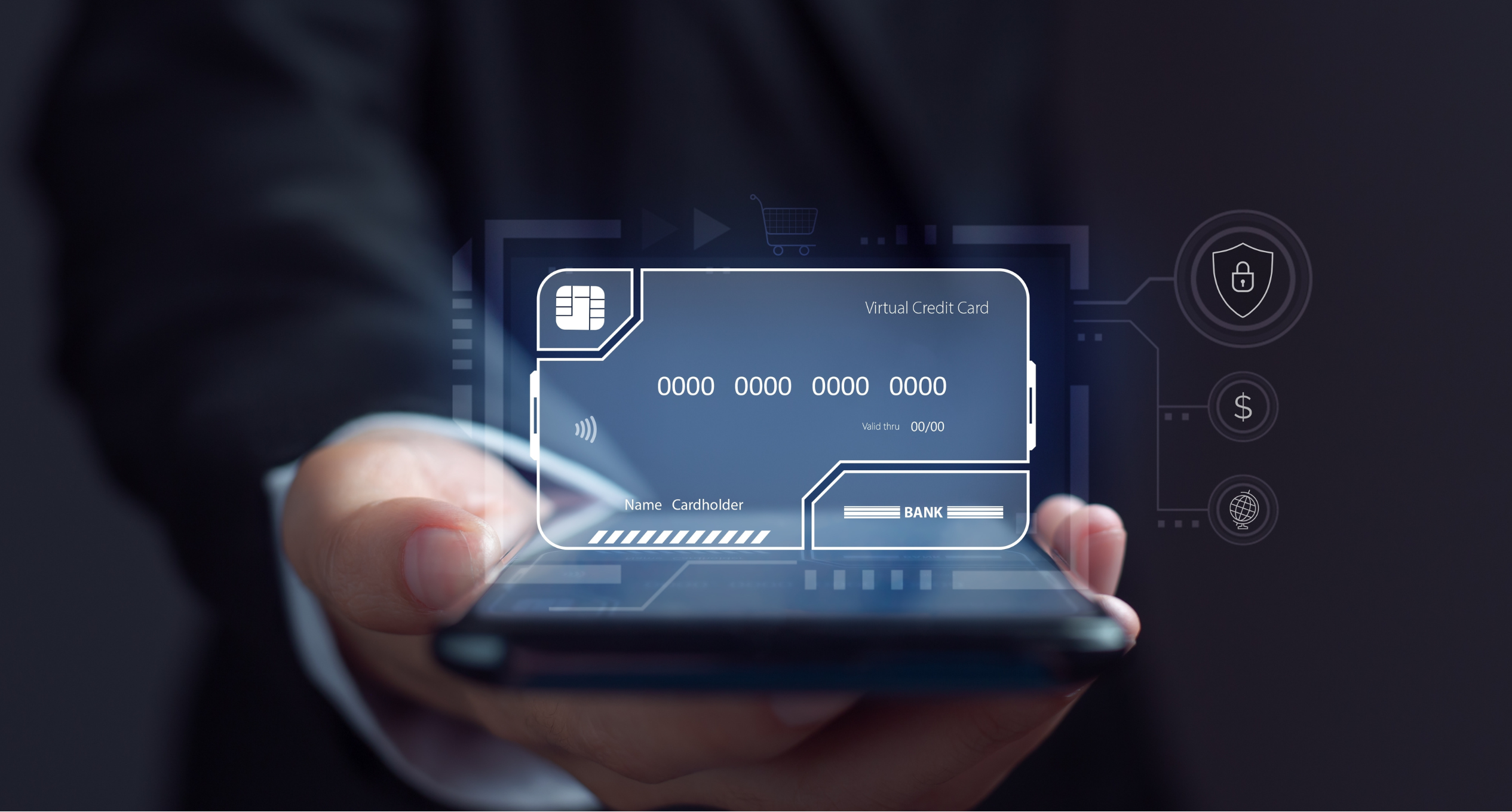
It seems that the COVID-19 pandemic and artificial intelligence (AI) have both helped accelerate the virtual world that many of us find ourselves living in today. It’s not surprising that virtual credit cards, sometimes known as temporary cards or digital credit cards, have become more popular in the past few years, particularly in regard to online shopping.
The growth is impressive, particularly in the B2B space. In fact, according to Versapay, a financial technology company that specializes in accounts receivable software, the global value of virtual card transactions is expected to rise nearly 260%, from $1.9 trillion in 2021 to $6.8 trillion in 2026.
While you might think virtual cards are designed mainly for convenience, the main goal of most virtual cards is actually to make your card more secure. This goal is timely given the fact that a recent report by Statista estimated that there was roughly 12 billion dollars in card fraud in 2022 in the U.S. alone.
There is a lack of consumer awareness and a lot of confusion about what exactly virtual cards are and how they work. I hope this article will help educate and inspire you- the adage that “knowledge is power” definitely applies here.
How do virtual credit cards work?
The term “virtual card” can be a bit misleading as most virtual cards are associated with a physical credit card (i.e. the traditional piece of plastic that we have all become accustomed to swiping, inserting or tapping). The notable difference is that virtual cards have a card number that is different than one’s regular account number.
Beverly Harzog, a nationally recognized card expert and author of “The Debt Escape Plan,” explains that “virtual cards are associated with randomly generated numbers that you can use for online shopping.” In short, “the number that’s generated isn’t the number on your actual physical card.”
Lynnette Khalfani-Cox, author of the New York Times bestseller “Zero Debt: The Ultimate Guide to Financial Freedom” and affectionately known as the Money Coach, adds that “virtual cards are computer-generated and are designed to thwart crooks who try to steal card data for their own gain.”
Some virtual numbers are only for one-time use (i.e. for one single online purchase or transaction). Khalfani-Cox notes that “virtual cards are sometimes called masked cards, single use cards or disposable cards because they’re usually meant for one-time use, or they’re designed to work with just one particular merchant.”
BONUS TIP!
If you decide to use virtual card numbers for online purchases, you can still use your physical card for in-person purchases. You may also be able to use virtual cards for mail order shopping or over the phone — in other words, with transactions where you don’t have to show your physical credit card.
Are virtual cards similar to digital wallets like Apple Pay?
Digital wallets, which are similar to virtual cards, have become increasingly widespread in the past few years. You may recognize some of the most popular digital wallet services, including Google Wallet, Apple Pay, Samsung Pay, Facebook Pay and Walmart Pay. Such services typically offer enhanced online security.
Harzog opines that a “digital wallet basically contains a digital version of your physical card and that you can use your card in your digital wallet to pay for purchases. When you pay, a token number is generated in place of your actual card number.” This token number is similar to the virtual numbers described above.
The differences between both services are somewhat subtle. In fact, both terms are sometimes used interchangeably. Harzog points out that they “both offer extra security, but the way they accomplish this differs.” Case in point, you can get a virtual card number from your card issuer without using a digital wallet. And one significant difference is that you can use your digital wallet for in-person purchases.
What are the pros and cons of virtual credit cards?
If you’re considering using a virtual number, it may be helpful to review a short summary of the advantages and disadvantages.
Pros:
- Additional security. Harzog points out that “if you make a purchase from a retailer and it gets hacked, your actual credit card number won’t be stolen. It’s an extra layer of security”. Khalfani-Cox adds that “if a crook can’t see your card number, then they can’t steal it and/or make unlawful purchases on your account.” The big benefit for many consumers is peace of mind.
- No additional charge. These services are normally free.
- Fast and convenient checkout. Streamlines your online checkout experience so that you don’t have to manually enter your card number or your CVV. This means you don’t need to have your physical card present when you checkout.
wHAT IS A CVV?
A card verification value, more commonly referred to as a CVV, is a three or four-digit number that is typically printed on the back of a credit card which acts as an additional security feature used to verify that the person making a purchase online or over the phone actually possesses the physical card.
Cons:
- Online use only. Numbers can only be used online, although there may be instances where you can use them over the phone or via mail order as mentioned above.
- Limited availability. Not all card issuers offer virtual cards, particularly smaller issuers (see below). Moreover, larger issuers that offer virtual numbers may only offer this benefit for certain cards.
- Returning merchandise may be a hassle. While issuers may claim that returns will work like normal, if you do a return in person, the store won’t have your virtual number (in order to issue you a refund), so you’ll likely need your receipt.
BONUS TIP!
Patronizing an online retailer with whom you’ve never done business with? Buying from an individual online seller you don’t know? Virtual numbers offer an ideal solution for these types of scenarios.
Where can you get a virtual credit card?
Virtual cards are currently offered by Citibank, Capital One and American Express. Let’s briefly look at the offerings of each of these three major card issuers.
- Select Citibank card customers can generate virtual numbers by logging in to their account. All purchases made with the temporary number will appear on monthly statements with other regular purchases. In addition, each charge will include the virtual account number that was used for each transaction.
- Capital One offers a complimentary service called ENO that generates a masked number. According to Khalfani-Cox, ENO allows users to lock, unlock or delete their virtual numbers at any time in order to have greater control and flexibility when shopping online. Eno is downloaded as an extension to your web browser.
- American Express bills its service as a fast and secure way to shop while using the Google Chrome web browser on your desktop or your Android mobile device, and where available, in Android apps. You can use your virtual number wherever Amex is accepted. Please Note! You can’t use your virtual number with Membership Rewards® Pay with Points at checkout.
If you have questions as to whether your card offers this benefit and/or how it works, Khalfani-Cox suggests “reaching out to your card company and inquiring about their masking features and process. You can do so by simply calling the toll-free number on the back of your card.”
BONUS TIP!
If your current card doesn’t offer virtual numbers, consider signing up for Click to Pay. This free service offers an extra layer of online security and was introduced in 2019 through a partnership between Visa, MasterCard and American Express.
Closing thoughts
Virtual cards are worth considering in select situations if you have a Citi, Capital One or American Express card that qualifies. If you don’t have a qualifying card, consider using a digital wallet or Click to Pay.
Regardless of which service you choose (if any), you should always be careful using your card whether online or in-person. As Khalfani-Cox wisely points out, don’t forget that “even big-name retailers can be hacked, compromising consumers’ data. For example, breaches have occurred at Target, Michaels, Neiman Marcus, etc.”
On a related note, if you do find yourself the victim of fraud, be sure to report it as soon as possible. That should help minimize your exposure because the Fair Credit Billing Act limits your liability to $50 for fraudulent charges. In addition, most issuers also offer their own $0 fraud liability protection.
Finally, while services like virtual cards offer increased convenience and are experiencing strong growth, it isn’t likely that physical cards will go away anytime soon. Harzog sums it up best by stating that “it’s great to use technology to improve security, but there are practical issues to consider. What if you’re out shopping and your phone dies for instance? The bottom line is that while it’s a good idea to embrace progress, keeping a physical card in your wallet or purse as a backup is also a good idea.”


